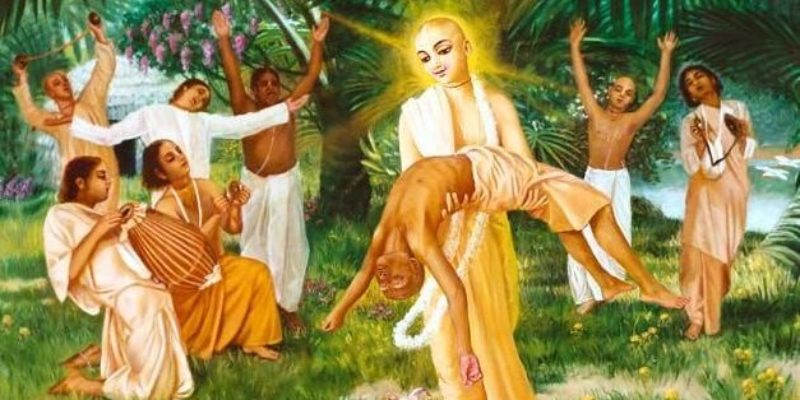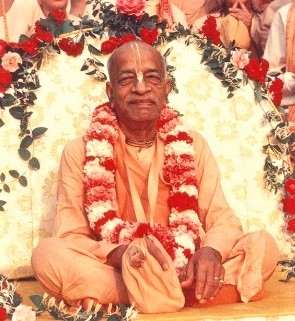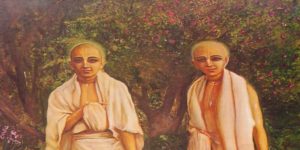jäti, kula, saba-nirarthaka’ bujhäite
janmilena néca-kule prabhura äjïäte
adhama-kulete yadi viñëu-bhakta haya
tathäpi se-i se püjya’—sarva-çästre kaya
uttama-kulete janmi’ çré-kåñëe nä bhaje
kule tä’ra ki karibe, narakete maje
ei saba veda-väkyera säkñé dekhäite
janmilena haridäsa adhama-kulete
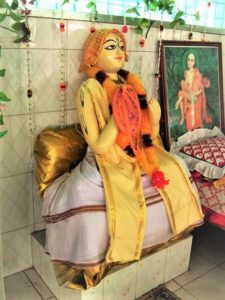
On the order of the Lord, Haridasa was born in a low-class family to show that birth in a high caste or good family are useless. If a devotee of the Lord is born in a low-class family, he is still worthy of worship. This is the verdict of the scriptures. And if someone is born in a high-class family but does not worship the lotus feet of Çré Kåñëa, then his high birth is useless and he falls to hell. Haridasa thus took birth in a low-class family to prove the words of the scriptures. Haridasa Thakura was born in a low-class family just as Prahläda was born in a demoniac family and Hanumän was born in a monkey family. The demigods desire the touch of Haridäsa, and even Gaìgä Devé desires that Haridäsa immerse himself in her waters.” (Caitanya-bhägavata Ädi-khaëda 16.237-242)
A Vaiñëava can appear in any cast. Srila Haridasa Thakura took birth as a Yavana to demonstrate that Vaiñëavas are above family lineage. It is mentioned in Çré Caitanya-bhägavata (Ädi-khaëda 16.18):
buòhäna-grämete avatérëa haridäsa
se-bhägye se-saba deçe kértana-prakäça
“Haridasa Thakura appeared in the village of Buòhana, and as a result that province is filled with kértana even today.”
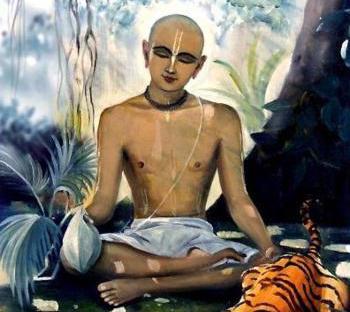
After Haridasa Thakura left his home in Budhana, he came to the Benapole jungle and stayed there for some years. There he bestowed his blessing on Lakñahéra (see next chapter for this pastime). From Benapole, he travelled some three kilometers to the bank of Naobhanga River and stayed there for some days. An ISKCON temple now marks this auspicious site. Haridasa then left the district of Jessore (now known as Jashore) and travelled to Hooghly district. He stayed in the village of Chandpur, near Saptagräma-Triveni, at the home Balaräma Äcärya, the family priest of Govardhana Majumdar, who was the father of Raghunätha däsa Gosvämé. After some time, he quit the region and moved to Phuliya, near Çäntipura, where he came into contact with Advaita Äcärya.
The two had utmost respect for each other. Advaita Prabhu gave Haridäsa the çraddhä plate instead of giving it to a senior brähmaëa, and said,
tumi khāile haya koṭi-brāhmaṇa-bhojana
eta bali, śrāddha-pātra karāilā bhojana
“Feeding you is equal to feeding ten million brāhmaṇas,” Advaita Ācārya said. “Therefore, accept this śrāddha-pātra.” Thus Advaita Ācārya made him eat. (Cc. Antya-lélä 3.222)
The primary reason for Mahäprabhu’s incarnation was the devotion and the emotional prayers of both Advaita Äcärya and Haridäsa Öhäkura.
kṛṣṇe avatārite advaita pratijñā karilā
jala-tulasī diyā pūjā karite lāgilā
Cc. Antya-lélä 3.224
Determined to deliver all the fallen souls, Advaita Ācārya decided to cause Kṛṣṇa to descend. With this vow, He began to offer Ganges water and tulasī leaves to worship the Lord.
haridāsa kare goṅphāya nāma-saṅkīrtana
kṛṣṇa avatīrṇa ha-ibena, —m ei tāṅra mana
Similarly, Haridāsa Ṭhākura chanted in his cave on the bank of the Ganges with the intention of causing Kṛṣṇa’s descent.
dui-janera bhaktye caitanya kailā avatāra
nāma-prema pracāri’ kailā jagat uddhāra
Because of the devotional service of these two persons, Lord Chaitanya Mahaprabhu descended as an incarnation. Thus He preached the holy name of the Lord and ecstatic love of Kṛṣṇa to deliver the entire world.
(Cc. Antya-lélä 3.224-226)
Sitting in a secluded cave near Çäntipura, Haridasa Thakura used to chant the holy names with devotion. Mäyädevé herself came to test him, taking the form of a beautiful woman, yet she admitted defeat and prayed to Haridäsa Öhäkura for his mercy. He gave her harinäma dékñä and thus Mäyädevé left fulfilled, saying,
pūrve āmi rāma-nāma pāñāchi ‘śiva’ haite
tomāra saṅge lobha haila kṛṣṇa-nāma laite
Formerly I received the holy name of Lord Rāma from Lord Śiva, but now, due to your association, I am greatly eager to chant the holy name of Lord Kṛṣṇa.
(Cc. Antya-lélä 3.256)
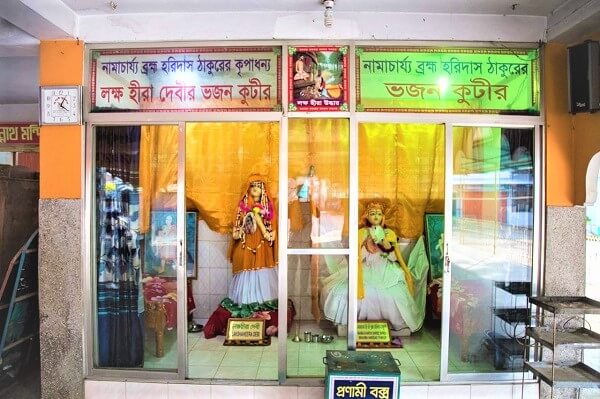
Haridasa Thakur constantly chanted the holy name, often calling the names of Kåñëa out loud. At that time, not many people were able to understand the value of this practice. One day, a brähmaëa from a village named Harinadi started a debate with Haridäsa on this subject. He argued that the names of the Lord should be meditated upon and that there was no reason to chant them aloud. He wanted to know in which scripture it was stated that one should chant aloud. In answer to these questions, Haridäsa said,
paçu-pakñé-kéöa-ädi balite nä päre
çunilei hari-näma tä’rä saba tare
apile çré-kåñëa-näma äpane se tare
ucca-saìkértane para upakära kare
taeva ucca kari’ kértana karile
çata-guëa phala haya sarva-çästre bale
“Although animals, birds, and insects cannot chant, when they hear the holy names they will all be delivered. If one silently chants the names of Krsna, then he is delivered; but if one loudly chants, then he delivers others also. Therefore the scriptures say that one gets a hundred times more benefit by chanting loudly.”
(Cb. Ädi-khaëda 16.280-282)
Then the fallen brähmaëa became furious and said that if the glories of holy name could not be found in scripture, he would publicly cut off Haridasa’s nose and ear as a punishment. For this offensive behaviour, the brähmaëa contracted smallpox not long afterward, and his own nose and ear fell off.
Haridasa Thakura then went to Navadvépa to take part in Mahäprabhu’s saìkértana pastimes. Mahäprabhu sent Haridäsa and Nityänanda Prabhu to go door to door to beg people to chant the names of Kåñëa, and to worship Him and study about Him:
sünä sünä nityänanda! sünä haridäsa!
sarvatra ämära ajïa karaha prakäça
prati ghare ghare giyä kara ei bhikñä
bolo kåñëa bhaja kåñëa kåñëa kara çikñä
(Cb. Madhya-khaëda 13.8)
Haridasa Thakura also engaged in water sports, acting in Vraja-lélä dramas and saìkértana with the Lord in Navadvépa. When Mahäprabhu went to Puré-dhäma after taking the vow of sannyäsa, Haridäsa also went and stayed in a solitary place arranged by Chaitanya Mahaprabhu. This place is now famous as Siddha Bakula.
Although Haridasa Thakura never went inside Jagannätha temple, Chaitanya Mahaprabhu – Lord Jagannätha Himself – went to visit Haridäsa daily. Out of humility, when Haridäsa would deny Chaitanya Mahaprabhu’s attempts to embrace him, Mahäprabhu said,
prabhu kahe, — tomā sparśi pavitra ha-ite
tomāra pavitra dharma nāhika āmāte
The Lord said, “I wish to touch you just to be purified, for your purified activities do not exist in Me.”
kṣaṇe kṣaṇe kara tumi sarva-tīrthe snāna
kṣaṇe kṣaṇe kara tumi yajña-tapo-dāna
Chaitanya Mahaprabhu exalted Haridāsa Ṭhākura, stating, “At every moment you take your bath in all the holy places of pilgrimage, and at every moment you perform great sacrifices, austerity and charity.
nirantara kara cāri veda adhyayana
dvija-nyāsī haite tumi parama-pāvana
You are constantly studying the four Vedas, and you are far better than any brāhmaṇa or sannyāsī.
(Cc. Madhya-lélä 11.189-191)
Mahäprabhu taught the glories of the holy name through Haridasa Thakura. He was adorned with the title of “Nämäcärya” by Mahäprabhu. The Muslim Nawab of Navadvépa, knowing Haridäsa to have been born in a Muslim family, rebuked him, saying, “Chant the names of God as they are found in your own religion and stop practicing other peoples’ religion. If you do not, you will have to face a very severe punishment.” Haridäsa Öhäkura answered with conviction:
khaëòa khaëòa hai’ deha yäya yadi präëa
tabu ämi vadane nä chäòi hari-näma
“Even if my body is cut into pieces and I give up my life, I will never give up chanting the Lord’s holy name.”
(Çré Bhaktyäloka 10)
In his last days, Haridasa would stay at Siddha Bakula, near the residence of Sri Caitanya Mahaprabhu, chanting constantly the holy names of the Lord. He knew that Mahäprabhu would soon be ending His pastimes in this world, and he wished to leave before Him. He wanted a boon from Chaitanya Mahaprabhu that he would see the lotus face of Gauräìga and chant çré kåñëa caitanya constantly. The affectionate Lord granted him his wish. Mahäprabhu took the divine body of Çréla Haridäsa on a kértana procession, and placed him in samädhi in the sand near the sea. By virtue of his presence, the seashore became a great place of pilgrimage.
How to Go There
Budhana is in Satkhira District in Bangladesh. Get down at Jhaudanga on Dhaka-Satkhira highway. The temple marking the birthplace of Çréla Haridäsa Öhäkura is about 8 km from there. The name of that place is Keragachi.
You can see other Holy Places. Click Here

